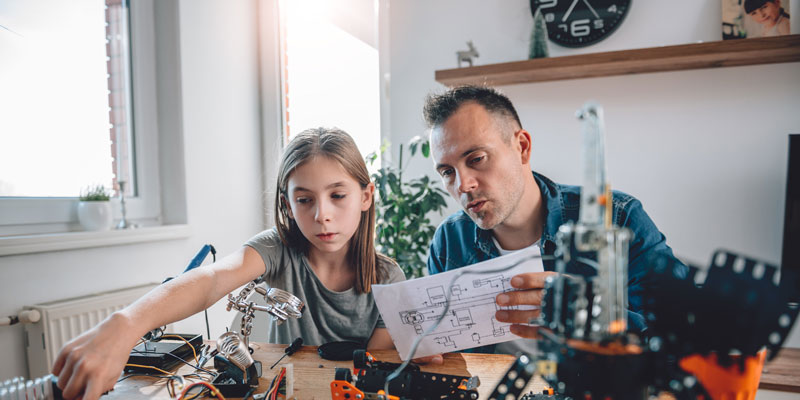Students are increasingly exposed to concepts of artificial intelligence and machine learning at a young age. They might not know what these terms mean and turn to you for help. This is a challenge if you personally have never explored these concepts.
Fortunately, there are plenty of tools and resources to help. Not only will you develop a firm grasp of machine learning and artificial intelligence, but your kids will be excited to explore these concepts with you.
How Can You Explain Artificial Intelligence to Kids?
The first step is to demystify the concepts of machine learning and artificial intelligence in your own mind, and then find the right tools to explain them to kids. Calum McClelland, director of projects at Leverege, clearly explains these concepts to anyone unfamiliar:
- “AI involves machines performing tasks that are characteristic of human intelligence.
- Machine learning is simply a way of achieving AI.”
While computers historically relied on people to tell them what to do and how to react, developers are creating machines that are able to learn. This means the robots can make their own decisions, giving them artificial intelligence.
This explanation might seem basic, but kids will flesh it out, expecting examples and asking follow-up questions. The best way to teach them about AI and its value is to compare it to items that are relatable to them.
“Many people for example have a pet dog and they may have even at a young age tried to train their dog to do tricks,” Michael Milford, author of The Complete Guide to Artificial Intelligence for Kids, tells Kinderling Radio. “Training artificial intelligence…is very similar to that process.”
Another example you can use to explain machine learning and AI is the Laundroid, a laundry-folding machine created by Seven Dreamers Laboratories.
When you dump a pile of clothes in the machine, the computer scans each item, compares it to a database to learn about it, and then makes folding decisions based on the information it finds. It takes about 10 minutes to fold each item as the robot learns. Talking about this while you and your child fold clothes right out of the dryer can demonstrate how technology needs to learn to complete simple tasks that we do without thinking.
These steps start the discussion of AI and ML in your home. The next steps are seeing them in action.
What Are Some Resources for Exploring AI at Home?
The internet is a great resource for expanding your knowledge of artificial intelligence and machine learning. Teachers, programmers and linguists come together to provide tools to understand these concepts.
- Tyler Schnoebelen, a linguistics and data specialist, created two definitions of AI: one for CEOs and one that kids could understand. Parents can do a deep dive in the first part of his article, and use the latter to discuss machine learning and answer questions from their children.
- Software engineer Alishah Novin says teachers and parents can create games that explain machine learning. He suggests using Starburst candies to replicate machine learning scenarios. Students can learn about probability, and then eat the candy. Even if a school lacks computer equipment, AI can be explained with a small bag of candy.
- Beanz, an online and print publication for kids interested in computers, discussed AI in their February 2016 issue. The example they use to explain intelligence is when a child touches a hot stove — and then remembers not to ever touch it again!
- Dann Albright, SaaS blogger, created a list of ways we use AI in our everyday lives including Siri, video games, and music and movie recommendation services like Netflix. Refer to this list when students ask for real life examples of AI that they already use.
- When in doubt, turn to AI researcher Sherol Chen. She created a three-step process for introducing the concept of AI to kids. This includes digging into questions like “why do computers exist?” and “how can we build better machines?” She provides video resources and activities that help demonstrate AI to children of all ages.
Are There Any Games for Teaching AI and Machine Learning?
Once you and your child understand the basics of artificial intelligence and machine learning, you can put them to the test! Try playing these games and activities to foster a deep understanding of AI and ML and see it in action.
- Pika is a camera app that takes kids on a colorful scavenger hunt. Kids are challenged to photograph colors and teach the robot to recognize those colors. They earn badges along the way and unlock features the robot can use.
- The simply-named Machine Learning for Kids works with Scratch and has worksheets for parents and teachers to walk kids through the AI and machine learning process. This game also encourages kids to teach the machine through image selection.
- Kano Computing lets kids build computers and program them to complete tasks. They have a guide for students who want to teach their machines to make art.
- Wonderville created a game called ViPER where children program a robot to explore Europa. The machine won’t be very smart at first, but learns as the kids teach it along the way.
- Dalton Learning Lab has multiple AI and Machine Learning education tools for parents and teachers. This option uses Scratch and is free for parents, but you do need to register and create an account.
Machine learning doesn’t have to intimidate kids, or parents! There are plenty of ways to learn together and explore this STEAM concept as a family.









